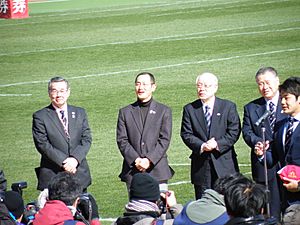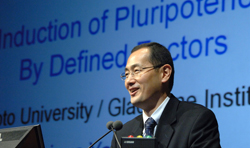Shinya Yamanaka facts for kids
Quick facts for kids
Shinya Yamanaka
|
|
|---|---|

Yamanaka in 2014
|
|
| Born | September 4, 1962 Higashiōsaka, Osaka, Japan
|
| Nationality | Japanese |
| Alma mater | Kobe University (MD) Osaka City University (PhD) |
| Known for | Induced pluripotent stem cell |
| Awards | Meyenburg Prize (2007) Massry Prize (2008) Robert Koch Prize (2008) Shaw Prize (2008) Gairdner Foundation International Award (2009) Albert Lasker Basic Medical Research Award (2009) Balzan Prize (2010) Kyoto Prize (2010) BBVA Foundation Frontiers of Knowledge Award (2010) Wolf Prize (2011) McEwen Award for Innovation (2011) Fellow of the National Academy of Sciences (2012) Millennium Technology Prize (2012) Nobel Prize in Physiology or Medicine (2012) |
| Scientific career | |
| Fields | Stem cell research |
| Institutions | Kyoto University Nara Institute of Science and Technology Gladstone Institute of Cardiovascular disease University of California, San Francisco |
Shinya Yamanaka (山中 伸弥, Yamanaka Shin'ya, born September 4, 1962) is a Japanese doctor and scientist who won the Nobel Prize for his amazing work with stem cells. He discovered a way to turn regular adult cells back into powerful stem cells, which has opened up new possibilities for medicine.
Dr. Yamanaka is a professor at Kyoto University in Japan and also works at the Gladstone Institutes in San Francisco, California. His work has changed what scientists thought was possible and has earned him many of the world's top science awards. In 2012, he shared the Nobel Prize in Physiology or Medicine with another scientist, Sir John Gurdon.
Contents
Early Life and Education
Shinya Yamanaka was born in Higashiōsaka, Japan, in 1962. His father owned a small factory that made parts for sewing machines. Growing up, Yamanaka was interested in science and medicine.
He went to Kobe University and earned his medical degree in 1987. He then trained to be an orthopedic surgeon, a doctor who fixes bones and joints. After getting his Ph.D. from Osaka City University in 1993, he moved to the United States for more training at the Gladstone Institutes in San Francisco.
A Scientist's Journey
As a young surgeon, Yamanaka realized that he might be better suited for research. An early surgery took him much longer than it would have taken an expert. Some of his senior colleagues even jokingly called him "Jamanaka," which sounds like the Japanese word for "obstacle."
He decided to focus on research, but it wasn't always easy. At one point, he felt he was just looking after lab mice instead of doing important experiments. His wife suggested he go back to being a regular doctor, but he was determined to make a breakthrough.
He got a job at the Nara Institute of Science and Technology by promising that he could figure out the secrets of embryonic stem cells. This confident attitude helped him get the position, and it was there that he began the research that would eventually win him the Nobel Prize.
A Groundbreaking Discovery: iPS Cells
In 2006, Dr. Yamanaka and his team announced a discovery that stunned the scientific world. They had figured out how to "reprogram" adult skin cells from mice and turn them back into stem cells. He called these new cells induced pluripotent stem cells, or iPS cells.
What Are Stem Cells?
Stem cells are like the body's master cells. They have the amazing ability to develop into many different types of cells, such as skin cells, brain cells, or heart cells.
- Embryonic stem cells, found in the earliest stages of development, are pluripotent. This means they can become any type of cell in the body.
- Adult stem cells are found in some body tissues, like bone marrow. They are multipotent, meaning they can only become a few types of cells (for example, different kinds of blood cells).
For a long time, scientists believed that once a cell became specialized, like a skin cell, it could never go back to being a pluripotent stem cell. Dr. Yamanaka's work proved this idea wrong.
How Did Yamanaka Make iPS Cells?
Dr. Yamanaka wondered if he could "rewind" a specialized cell and make it pluripotent again. He focused on transcription factors, which are proteins that turn genes "on" or "off" inside a cell, telling it what kind of cell to be.
He and his team tested 24 different transcription factors that were known to be important in embryonic stem cells. Through many experiments, they narrowed down the list until they found a magic recipe: just four key factors were needed. When they introduced these four factors into an adult skin cell, it transformed back into a pluripotent stem cell.
This was a huge breakthrough for several reasons:
- It avoided the ethical debates around using embryonic stem cells.
- It meant that one day, doctors could create stem cells from a patient's own skin. These cells could then be used to treat diseases without the body rejecting them.
A year later, in 2007, his team successfully created iPS cells from human adult cells.
Why This Discovery Matters
Dr. Yamanaka's discovery of iPS cells opened up a whole new field of medicine called regenerative medicine. The goal of this field is to repair or replace damaged tissues and organs.
Here are some of the exciting possibilities:
- Studying Diseases: Scientists can take skin cells from a person with a genetic disease, like Parkinson's or heart disease, and turn them into iPS cells. They can then grow these cells into brain or heart tissue in a lab dish to study how the disease works and test new drugs.
- Cell Replacement Therapy: In the future, doctors might be able to grow healthy new cells from a patient's iPS cells. These new cells could then be transplanted into the patient to replace cells that have been damaged by injury or disease.
- Testing New Medicines: New drugs can be tested on human cells grown from iPS cells. This could make drug development safer and more effective.
In 2013, scientists in Japan used iPS cells to grow a small, functioning human liver in a mouse. This showed the amazing potential of this technology. Research continues to make iPS cell technology safer and more efficient for use in patients.
Recognition and Awards
For his incredible work, Dr. Yamanaka has received many honors from around the world.
- In 2010, he won the prestigious Kyoto Prize.
- In 2012, he shared the Millennium Technology Prize with Linus Torvalds, the creator of the Linux computer operating system.
- His greatest honor came in 2012 when he was awarded the Nobel Prize in Physiology or Medicine.

Personal Life
Outside of the laboratory, Dr. Yamanaka is a dedicated athlete. He played rugby in college and is an avid marathon runner. He often runs in marathons to raise money for his iPS cell research. He proves that it's possible to have a passion for both science and sports.
See also
 In Spanish: Shin'ya Yamanaka para niños
In Spanish: Shin'ya Yamanaka para niños
- Catherine Verfaillie
- List of Japanese Nobel laureates
- List of Nobel laureates affiliated with Kyoto University
- Tasuku Honjo


